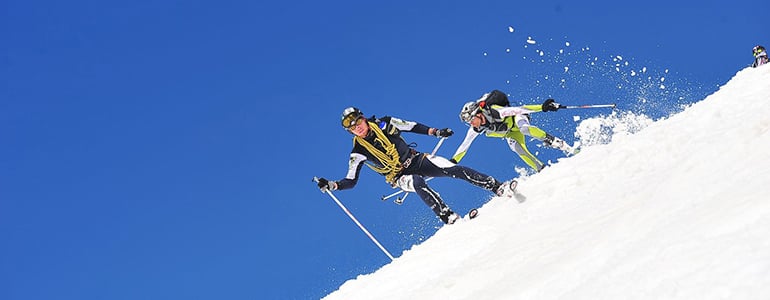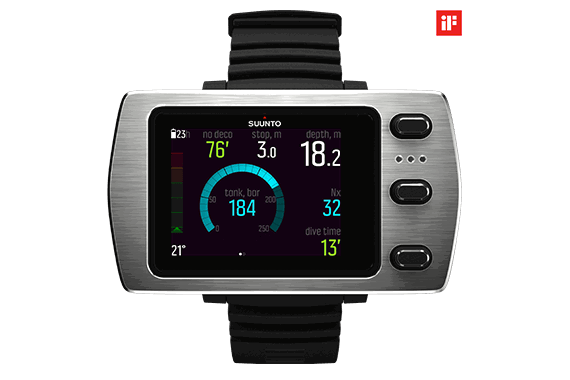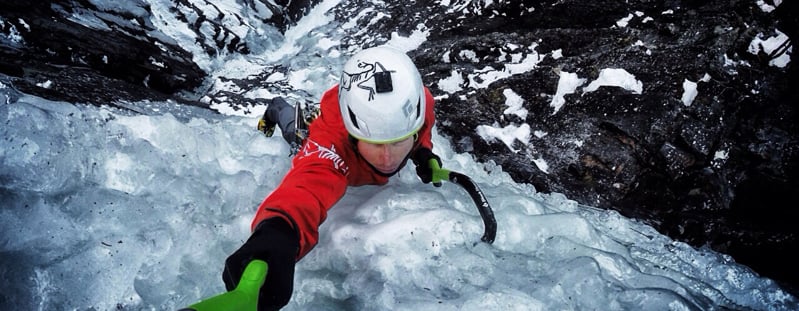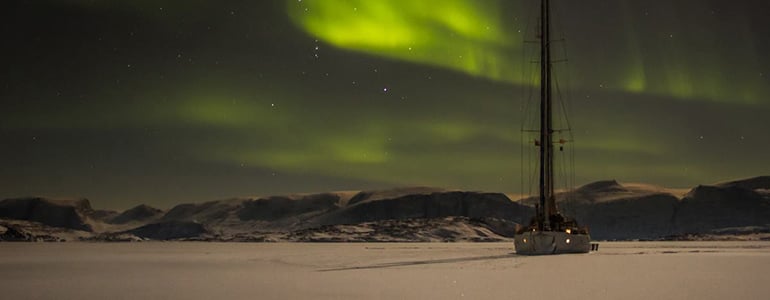

Suunto Blog

The Mezzalama Trophy: Meet the world’s toughest Ski Race
The Mezzalama Trophy is one tough challenge. The iconic, high-altitude ski mountaineering race takes place in the Cervinia region of Italy every other year, and sees about 300 teams of three skiers tackle some of the toughest terrain in the Alps. We take a closer look at this historic competition and the Suunto athletes training for the 20th edition of the race. As part of the “big three of ski mountaineering,” The Mezzalama Trophy is among the highest alpine ski mountaineering events of the world. It's a 45 km race with 3,430 m of vertical ascent. But it’s not only the competition’s toughness and high altitude that makes it so appealing – it’s Mezzalama’s history. Established back in 1933, it’s one of the oldest races of its kind, and holds historic significance in the minds of many skiers. Like in 1934, when a young German solo skier called Anderl Heckmair overtook all competing teams despite starting one-and-a-half-hours after the pack. Heckmair would later achieve global fame for leading the hardest pitch during the first ascent of the North Face of the Eiger four years later. Check out the Mezzalama Trophy Trailer below:
This year, in commemorating 150 years since the first ascent of the Matterhorn, the Mezzalama Trophy route will run in reverse. The race will guide athletes from Gressoney-la-Trinité to Breuil-Cervinia – the exact opposite of previous editions. The change adds about 350 meters of altitude to the route.Of those competitors, Suunto ambassador, Kilian Jornet will once again join his teammates in Italy. “As every year, I'm happy to compete and be able to combine different modalities and distances,” says Kilian.Also in the lineup, and further down the pack, will be a team from Suunto made up of guide Fabien Meyer, ice climber Matthias Scherer and digital manager for France, Franck Largeault. “Heckmair's incredible dedication to alpinism is for me a great example of the spirit of mountaineering,” says Matthias. “I would never dare to compare myself to him but I love his commitment and spirit. He was psyched to run this race, to be out in the mountains, to feel strong and alive. I am stoked to race it!”
Franck Largeault is preparing for the challenge of his life. ©Franck Largeault
The team have been training hard. “To create any good training plan, a good starting point is required,” Largeault says. “We therefore conducted aerobic and technical stress tests to assess our fitness levels. These starting points allowed us to establish our training plan and use the remaining 6 weeks to prepare.” Largeault explains: “We used the Ambit 3 Peak to perform the tests by measuring our heart rates, climbing rates etc.”The 2015 edition of the extraordinary Mezzalama Trophy kicks off on April 25. Stay tuned for more updates.
Images ©pantacolor.it

Suunto EON Steel wins prestigious award
Suunto’s next generation dive computer receives global iF Design Award 2015
Suunto is pleased to announce that Suunto EON Steel, the fully customizable dive computer, has been awarded the iF Design Award 2015 in the Product category. This award is an important recognition of the Finnish company's success in developing diving innovations in the last 50 years.
Handmade in Finland, Suunto EON Steel combines advanced technology with a bright color screen and customizability to let you choose exactly what you want to see on your dive. The easy-to-use dive computer was developed in close relationship with active divers around the world. It has been extensively tested including dives in the caves of an old limestone mine in Ojamo, Finland. Creating reliable products designed for the harshest of elements has been a part of Suunto’s heritage for almost 80 years.
Comments Björn Bornemann, the Designer of Suunto EON Steel: “We’re thrilled to receive this prestigious award which is a fitting tribute to the hard work of the whole product team. With heavy-duty housing, a stainless steel bezel, and user updatable software, Suunto EON Steel is built to last.”
The iF Product Design Award was introduced in 1954 and is a highly prized seal of quality annually conferred by the International Forum. Every year the iF attracts more than 2,000 product entries from around 37 nations, which are judged by renowned experts. www.ifdesign.de

As hard as ice: Matthias Scherer's battle with a Norwegian winter
For ice-climber and Suunto ambassador, Matthias Scherer, winter is naturally a busy time. Recently, Matthias made a trip to Norway, where over the past few years, he’s gone in search of the ultimate ice lines. And this time, tucked away in the Fjords of the West Coast, he found just what he was looking for.
Approaching Fjåene Fossen © Matthias Scherer“Ice climbing, like alpinism is always a quest. A quest for the ultimate ice line,” says the German climber.It’s that quest which lead Matthias back to Norway – a place where he had tried twice in vain to scale the lines buried deep within in the Fjords near Bergen. He was forced to retreat on both occasions due to bad conditions.“This time we checked the temperatures via the internet and decided to give it a go during the beginning of February. We knew that we had to be prepared both mentally and physically to face this big adventure.”
A little clip of Matthias climbing in his home ground of Cogne, Italy in January.
Arriving in Norway, his ‘adventure’ started almost immediately when a snowstorm blocked all the roads on his way in. And when the expedition finally commenced, Matthias and his crew were faced with crossing a waist-deep river of freezing water before reaching their line.“The climb up ‘Fjåene Fossen’ proved to be, as expected, an epic battle: bad ice quality and lots of water and snow pouring down on us. After several hours we reached the top of the line in a raging storm,” he says. But for Matthias, achieving one objective only leads to the next, on the way down they discovered another awesome-looking line.“Two days later in an even heavier storm, we reached the top of that line. We named it 'Stormbringer'.”
On Pattinaggio © Matthias SchererYou’d think that after his Norwegian excursion, Matthias would kick back for a few days. Wrong. The climber has been busy climbing lines on his home turf of Cogne, Italy, as well as another trip back to Norway to climb in Rjukan. He's already looking forward to going back next year.
“And next winter, I’ll be back on Norwegian ice once again.”
KERBER’S AMAZING WINTER WING SUIT FLIGHT – IN THE DARK
Have you ever thought of BASE jumping? With a wingsuit? In full winter conditions? In the dark? With two burning torches? Neither have we. But Patrick Kerber and his friends did – and the result, a photo by Christian Meier, looks amazing.
© Christian Meier / www.chrigel.li
“My friend Simon Wandeler and I have wanted to do a wingsuit BASE flight at night during winter for a very long time. But somehow we never really managed to do it,” the Swiss wingsuit flyer says.
The idea picked up momentum after Kerber’s friend, photographer Fabian Wyss approached him with an idea of attaching some kind of light to the jumper.
“When he told me his idea, I instantly understood what he wanted to do and could envision how this picture could turn out.”
FLYING WITH A TORCH
The first problem they faced was how to attach a light to the jumper that would be bright enough to be seen from a distance of about two kilometers. And of course it is not easy to attach a light to a wingsuit without changing the flying characteristics of the suit.
“Then I had the idea of attaching flares to myself, exactly like the ones used for rescue missions or emergencies. But flares burn very, very hot and my biggest fear was burning holes or melting the suit. That would have been super dangerous.”
Another challenge was finding a proper location that could be accessed in winter conditions at night and also photographed. After some research and tests they chose one of Kerber’s regular jumping spots, the east face of Titlis in Engelberg in Switzerland. The two photographers, Fabian Wyss and Christian Meier, stood on the other side of the valley on the Fürrenalp.
“There definitely was a lot of pressure – even though we did intense testing before, I did not know for sure how it would turn out. Having fire really close to you on a wingsuit BASE flight leaves no margin for error. Everything has to work out.”
EVERY SECOND COUNTS
The big challenge for the image was timing. One single torch would burn for exactly one minute.
“I definitely did not want to open up my parachute with fire still around me, as this could be very dangerous. I only have one single parachute attached to me. If this one burns or melts, it's over!”
Kerber decided to use two torches. The first one he ignited before he took off and held in his right hand so it would be visible to the photographer. When the torch burned out, he quickly opened up his parachute and ignited a second torch attached to his foot. (That’s the break in the red line in the image.)
“I only had 20 seconds to ignite the second one as it also burned for one minute and I only had 1 minute and 15 seconds to the landing area. I did not want to land with a flare still on fire, as this could be very dangerous for my gear and for myself. Even though there was snow where I landed, those torches burn so hot that they even burn underwater!”
Patrick Kerber has jumped at night before, but not in winter and only at full moon.
“The feeling was very intense and amazing. It is much harder to orientate yourself, as you can't see as well. It feels much more intense because you fly with more feeling and awareness of your body and movements.”
For Kerber wingsuit flying is about freedom.
“For me freedom is a moment of pure perfection and pure happiness, a moment where all that matters is now.”
Watch a behind the scenes video of Patrick Kerber’s flight.

Get running, says Ryan Sandes
Now's the perfect time to be out there running, says Suunto ambassador Ryan Sandes, well – at least it is in the southern hemisphere. The Cape Town based runner is making the most of mid-summer weather to gear up for a couple of big projects for 2015, as he tells us below. What's in your sights: I'm very excited by the challenge of new races. I'm looking forward to TransVulcania in May. The distance of 83km will suit me. What else?The Western States. I've done it twice so I'm going there with high expectations! I've never run the UTMB and hope to run that in 2016. Another key 100 miler on my list is the Raid Reunion.
Ryan during the Grand Drakensberg Traverse FKT ©Kelvin Trautman / Red Bull Content Pool Racing or FKT, what makes your heart beat? I enjoy racing but what drives me is the FKT movement. [Fastest Known Times: the challenge of setting a record time on a set route, typically up or across mountains, organised independently.]I enjoy the whole adventure of setting yourself a challenge, the whole behind the scenes thing, checking maps, preparing, not knowing what lies ahead, it beats my soul. That really excites and motivates me. In a race you know you will finish. With an FKT you don't actually know if you will and that's really exciting. There are a few FKTs I'm looking at. Most are in Africa around Kenya and Tanzania.
Ryan pictured at home in South Africa ©Kolesky/Nikon/Red Bull Content Pool Tell us about the Grand Drakensberg Traverse. [In March 2014 Ryan Sandes and Ryno Griesel smashed the FKT for the 204km traverse of the Drakensberg mountains in South Africa, running the wild mountain ridgeline in 41h and 49m.]It was really cool to achieve but it wasn't just about running the fastest time. It was the whole experience of crossing the mountains north to south.What was the hardest part? The preparation when we scouted the route! We had really bad weather – I've never seen anything like it. There was snow, hail, lightning and torrential rain. It was pretty scary! The next time I got hammered by the altitude. Every time an element humbled me. Peak or Sport?I'm using the Ambit3 Sport Blue and really enjoying that. The Suunto Movies are really cool. But for my longer runs I'm more of a Peak guy for the longer battery. It's really useful to be able to track my distance and climbs.
Ryan running the Fish River canyon in 2012 ©Kolesky/Nikon/Red Bull Content PoolWhat's next? I'm setting up an FKT that other people can try but can't say any more at the moment! Suunto ambassador Ryan Sandes, 32, won the 4 Desert series in 2010 and won the Leadville 100 in 2011.

Patience Under The Pole
In their latest update from Greenland, the Under the Pole team share their adventures, which included violent Arctic winds, and a memorable Christmas party.“We say that the Arctic is the school of patience,” writes expedition leader, Ghislain Bardout in his latest newsletter. “It takes us 20 minutes of preparation to get out the boat, one hour to remove the snow from the deck every morning, four hours to prepare a scuba dive, and we haven’t seen the sun in four months.”
This is a day in the life of Ghislain Bardout and his team of French explorers, as they wait patiently for spring to arrive and continue their ambitious scientific expedition off the Greenland coastline.
Diving base camp next to the iceberg. © Lucas Santucci / Under The Pole
He says: “While we waited for the sea-ice and sun to come out, we had some great Christmas parties at Uummannaq. And New Year’s Eve was one of the best we’d ever experienced: locals launched hundreds of fireworks into the sky – it became a magical show above the snowy city.”The team then headed to their winter location and had a three-day stopover at Ikerasak to lend the locals a hand. “Véronique, our physician, examined several local people, and Sylvain, our fixit man, repaired the local school’s informatics network.” Ghislain says.January proved to be a difficult month for the team, as they endured several days of violent Arctic winds, halting all activity. “We registered averages of 50 knots and gusts up to 80 knots. It’s in these kind of situations that we’re happy to have two anchors!” adds Ghislain. The team is now planning for the next leg of their exhibition – the sea-ice scientific program.Under The Pole is a series of submarine polar expeditions aiming to explore the hidden face of the Arctic and Antarctic Polar Regions in their diversities. Suunto is an expedition partner.
Main image ©Under The Pole










































































